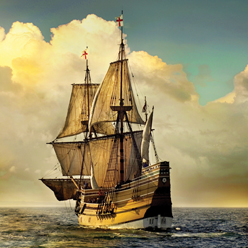 For want of a nail, or a horseshoe, unforeseen consequential damages may follow.1 For the Pilgrims aboard the Mayflower, however, it was a screw jack—not a nail—that provided providential protection.
For want of a nail, or a horseshoe, unforeseen consequential damages may follow.1 For the Pilgrims aboard the Mayflower, however, it was a screw jack—not a nail—that provided providential protection.
Halfway through the Pilgrims’ journey across the Atlantic Ocean, an overstressed beam bowed and cracked. The screw jack was used to “save the day.”2 Think of how American history would have changed if the Pilgrims had all perished at sea, never to reach Plymouth in 1620.
Think of how American history would have changed if the Pilgrims had all perished at sea. ![]()
Originally this giant screw device was used for clamping inked typesetting fonts onto printing press paper, but on the Mayflower it was re-tasked to raise a midship beam back into place after it had faltered, followed by buttressing the compromised beam with subjacent support.
[The Mayflower] encountered many times with cross winds and met with many fierce storms…and one of the main beams in the midships was bowed and cracked, which put them in fear that the ship could not be able to perform the [remainder of the] voyage.…[So] there was a great iron screw the passengers brought out of Holland [i.e., the screw press Brewster used in Leiden], which would raise the beam into [its] place; the which being done, the carpenter and [ship] master affirmed [i.e., buttressed] that with a post put under it, set firm in the lower deck and other[wise] bound, he would make it sufficient.3
This providential detail is...something we can appreciate during the Thanksgiving season. ![]()
Available machinery capable of versatile applications, combined with quick-thinking Pilgrim passengers, solved a life-or-death crisis that the Mayflower’s professional crew hadn’t anticipated. This providential detail is part of the Pilgrims’ progress in America—and thus is something we can appreciate during the Thanksgiving season.
We can also appreciate how God has programmed so much of His great creation with versatile engineering traits, including multitasking features within our own bodies such as our appendix, nose, ears, and hair.4
Appreciate how God has programmed so much of His great creation with versatile engineering traits. ![]()
Human inventors are routinely commended for devising versatile utility gadgets, like Swiss army knives that contain multipurpose features for accomplishing work in diverse contexts. Yet, consider how the human appendix helps the immune system as well as the digestive system. Consider also how the human ear provides hearing as well as our sense of balance. Noses both smell and breathe. Hair provides beauty while it simultaneously excretes toxins. Examples of God’s multitasking in human physiology are almost endless.
Likewise, we should revere God’s genius when we see it displayed in animals’ multitasking body parts.5 Even the inanimate sun, moon, and stars were made by God for multipurpose tasks (Genesis 1:14-18).
God’s bioengineering always outshines manmade mechanical marvels. ![]()
God’s bioengineering always outshines manmade mechanical marvels, so we should give God due credit for how He designed and constructed His diverse creation, especially ourselves, with multitasking potentials that show design genius far beyond mere “irreducible complexity.” As always, we have a lot to be thankful for, so let us be grateful to our God for His many providences, including those that provided political and religious freedoms and opportunities.
Know that the LORD, He is God;
It is He who has made us, and not we ourselves;
We are His people and the sheep of His pasture.
Enter into His gates with thanksgiving,
And into His courts with praise.
Be thankful to Him, and bless His name.6
References
- British Columbia Saw-Mill Co. v. Nettleship, L.R. 3 C.P. 499 (Eng. Q.B. 1868), alluding to a case “where a man going to be married to an heiress, his horse having cast a shoe on the journey, employed a blacksmith to replace it, who did the work so unskillfully that the horse was lamed, and, the rider not arriving in time, the lady married another; and the blacksmith was held liable for the loss of the marriage.”
- What saved the day, mechanically speaking? It was a “great iron screw” (i.e., a screw press or screw jack) brought from Leiden, Holland, from William Brewster’s government-quashed printing press operation. “Certainly the screw itself, of which Bradford speaks,…was used to raise the bending beam and bring it back into position, and would be removed as soon as the upright post was in its place.…It was a screw-press or screw-jack: probably all that was left of Brewster’s printing house, after the types had been seized by the Leyden authorities.” Harris, R. 1920. The Finding of the “Mayflower.” London: University Press, 14-15. Posted on washingtonmayflower.org.
- Bradford, W. 1989. Of Plymouth Plantation, 1620-1647. S. E. Morison, ed. New York: Alfred A. Knopf, 58-59.
- Psalm 139. See also Romans 1:20, cited in Guliuzza, R. 2010. Life’s Indispensable Microscopic Machines. Acts & Facts. 39 (8): 10-11. Many manmade machines are designed for versatility, the flexible potential for “multitasking” services.
- “Biologists [studying birds and flying insects] continue to uncover exquisite design in natural flight sensors—devices like mechanoreceptors that send sophisticated information to an insect’s brain about the visual field, airflow, inertia, and wing-load pressure. Investigations have revealed that most or perhaps all natural sensors multitask. A single biological sensor can detect, integrate, and send multiple messages to the creature’s brain,” citing Acts 17:24. Thomas, B. Birds Inspire Flight Sensor Inventions. Creation Science Update. Posted on icr.org December 22, 2014, accessed September 20, 2017.
- Psalm 100:3-4.
* Dr. Johnson is Associate Professor of Apologetics and Chief Academic Officer at the Institute for Creation Research.



















